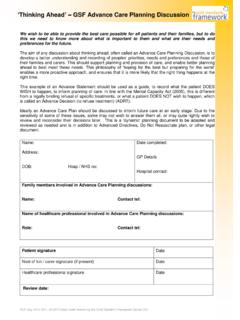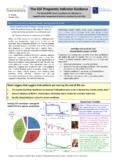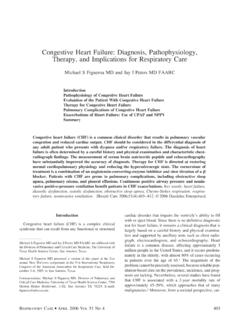Transcription of The Gold Standards Framework Proactive Identification ...
1 The Gold Standards FrameworkProactive Identification Guidance (PIG)The National GSF Centre s guidance for clinicians to support earlier Identification of patients nearing the end of life leading to improved Proactive person-centred careGSF PIG 6th Edition Dec 2016 K Thomas, Julie Armstrong Wilson and GSF Team, National Gold Standards Framework Centre in End of Life Care for more details see GSF PIGP roactive Identification Guidance proactively identifying patients updated 6th edition of the GSF PIG, renamed as Proactive Identification Guidance and formally known as Prognostic Indicator Guidance, aims to enable the earlier Identification of people nearing the end of their life who may need additional supportive care. This includes people who are nearing the end of their life following the three main trajectories of illness for expected deaths rapid predictable decline cancer, erratic decline organ failure and gradual decline frailty and dementia.
2 Additional contributing factors when considering prediction of likely needs include current mental health, co-morbidities and social care is it important to identify patients early?Earlier Identification of people who may be in their final stage of life leads to more Proactive person-centred care. About 1% of the population die each year, with about 30% hospital patients and 80% of care homes residents in their last year of life. Most deaths can be anticipated though a minority are unexpected (estimated about 10%). Earlier recognition of decline leads to earlier anticipation of likely needs, better planning, fewer crisis hospital admissions and care tailored to peoples wishes. This in turn results in better outcomes with more people living and dying in the place and manner of their choice. Once identified, people are included on a register and where available the locality/electronic register, triggering specific active supportive care, as used in all GSF programmes and in GSF cross boundary care and GSF Early Proactive Identification of patients is the crucial first step of GSF, used by many thousands of doctors and nurses in the community and hospitals.
3 For more information on GSF, how it is used in practice to help identify patients early, assess needs and wishes through advance care planning discussions and plan care tailored to patient choices, see the GSF Policy support for earlier Medical Council GMC definition of End of Life Care; People are approaching the end of life when they are likely to die within the next 12 months. This includes people whose death is imminent (expected within a few hours or days) and those with : Advanced, progressive, incurable conditions. General frailty and co-existing conditions that mean they are expected to die within 12 months. Existing conditions if they are at risk of dying from a sudden acute crisis in their condition. Life threatening acute conditions caused by sudden catastrophic events.
4 NICE Guidance in End of life care 2011 Quality statement 1 Identification People approaching the end of life are identified in a timely way. Systems Evidence of local systems in place to document Identification of people approaching the end of life. Proactive Identification Guidance GSF PIG Flow-chartThe GSF Proactive Identification Guidance (PIG) 2016 vs6 The Gold Standards Framework Centre in End of Life Care For more information on the development of the GSF PIG, its use in practice, evidence base, applications and when referencing it, please refer to For more details contact 01743 291891 Identifypatients who may be in their last year of life and identify their needs-based code/stageAssesscurrent and future, clinical and personal needsPlanliving well and dying well Sudden unexpected death Three trajectories of illness (Lynn et al) reflecting the three main causes of expected death Average GP has about 20 patient deaths / year 1.
5 Rapid predictable decline Cancer 2. Erratic unpredicatable Organ failure 3. Gradual decline frailty, dementia, multi-morbidity Step 1 Ask the Surprise Question Would you be surprised if the patient were to die in next year, months, weeks, days? Don t Know NO Do they have General Indicators of Decline? YES Do they have Specific Clinical Indicators? Don t Know Begin GSF Process Identify - Assess - Plan Step 3 Step 2 2 YES Reassess regularly NO YES Reassess regularly NO Reassess regularly The 3 key steps of GSFThe Surprise QuestionFor patients with advanced disease or progressive life limiting conditions, would you be surprised if the patient were to die in the next year, months, weeks, days?The answer to this question should be an intuitive one, pulling together a range of clinical, social and other factors that give a whole picture of deterioration.
6 If you would not be surprised, then what measures might be taken to improve the patient s quality of life now and in preparation for possible further decline?General indicators of decline and increasing needs? General physical decline, increasing dependence and need for support. Repeated unplanned hospital admissions. Advanced disease unstable, deteriorating, complex symptom burden. Presence of significant multi-morbidities. Decreasing activity functional performance status declining ( Barthel score) limited self-care, in bed or chair 50% of day and increasing dependence in most activities of daily living. Decreasing response to treatments, decreasing reversibility. Patient choice for no further active treatment and focus on quality of life. Progressive weight loss (>10%) in past six months. Sentinel Event serious fall, bereavement, transfer to nursing home.
7 Serum albumin <25g/l. Considered eligible for DS1500 Clinical Indicators related to 3 trajectories 1. Cancer Deteriorating performance status and functional ability due to metastatic cancer, multi-morbidities or not amenable to treatment if spending more than 50% of time in bed/lying down, prognosis estimated in months. Persistent symptoms despite optimal palliative oncology. More specific prognostic predictors for cancer are available, Organ failure Heart DiseaseAt least two of the indicators below: Patient for whom the surprise question is applicable. CHF NYHA Stage 3 or 4 with ongoing symptoms despite optimal HF therapy shortness of breath at rest on minimal exertion. Repeated admissions with heart failure 3 admissions in 6 months or a single admission aged over 75 (50% 1yr mortality). Difficult ongoing physical or psychological symptoms despite optimal tolerated therapy.
8 Additional features include hyponatraemia <135mmol/l, high BP, declining renal function, anaemia, Obstructive Pulmonary Disease (COPD)At least two of the indicators below: Recurrent hospital admissions (at least 3 in last year due to COPD) MRC grade 4/5 shortness of breath after 100 metres on level Disease assessed to be very severe ( FEV1 <30% predicted), persistent symptoms despite optimal therapy, too unwell for surgery or pulm rehab. Fulfils long term oxygen therapy criteria (PaO2< ). Required ITU/NIV during hospital admission. Other factors , right heart failure , anorexia, cachexia, >6 weeks steroids in preceding 6 months, requires palliative medication for breathlessness still DiseaseStage 4 or 5 Chronic Kidney Disease (CKD) whose condition is deteriorating with at least two of the indicators below: Patient for whom the surprise question is applicable.
9 Repeated unplanned admissions (more than 3/year). Patients with poor tolerance of dialysis with change of modality. Patients choosing the no dialysis option (conservative), dialysis withdrawal or not opting for dialysis if transplant has failed. Difficult physical or psychological symptoms that have not responded to specific treatments. Symptomatic Renal failure in patients who have chosen not to dialyse nausea and vomiting, anorexia, pruritus, reduced functional status, intractable fluid DiseaseHepatocellular transplant contra indicated. Advanced cirrhosis with complications including:Liver Disease continued Refractory ascites Encephalopathy Other adverse factors including malnutrition, severe comorbidities, Hepatorenal syndrome Bacterial infection current bleeds, raised INR, hyponatraemia, unless they are a candidate for liver transplantation or amenable to treatment of underlying Neurological Diseases Progressive deterioration in physical and/or cognitive function despite optimal therapy.
10 Symptoms which are complex and too difficult to control. Swallowing problems (dysphagia) leading to recurrent aspiration pneumonia, sepsis, breathlessness or respiratory failure . Speech problems: increasing difficulty in communications and progressive s Disease Drug treatment less effective or increasingly complex regime of drug treatments. Reduced independence, needs ADL help. The condition is less well controlled with increasing off periods. Dyskinesias, mobility problems and falls. Psychiatric signs (depression, anxiety, hallucinations, psychosis). Similar pattern to frailty see Neurone Disease Marked rapid decline in physical status. First episode of aspirational pneumonia. Increased cognitive difficulties. Weight Loss. Significant complex symptoms and medical complications. Low vital capacity (below 70% predicted spirometry), or initiation of NIV.













